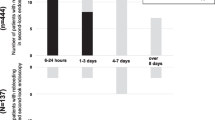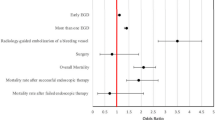Abstract
Background and Aim
Patients with bleeding ulcers can have recurrent bleeding and mortality after endoscopic therapy. Risk stratification is important in the management of the initial patient triage. The aim of this study is to identify the clinical and laboratory risk factors for recurrent bleeding and mortality.
Methods
A prospective study was conducted in 390 consecutive patients with bleeding peptic ulcers and high-risk endoscopic stigmata, e.g., active bleeding, a non-bleeding visible vessel, adherent blood clot, and hemorrhagic dot. We tested 13 available variables for association with recurrent bleeding and 15 were tested for association with mortality. A logistic regression model was used to identify individual correlates associated with these adverse outcomes.
Results
Bleeding recurred in 46 patients (11.8%) within 3 days and 21 patients (5.4%) had in-hospital mortality. In the full-factor analysis model, the incidence of recurrent bleeding was significantly higher in five of the 13 investigated variables and mortality was significantly higher in two of the 15 variables. In the final analysis model, significant risk factors for recurrent bleeding within 3 days, with adjusted odds ratios (OR), were in-hospital bleeding (OR 3.3), initial hemoglobin level <10 g/dl (OR 3.3) and ulcer ≥2 cm (OR 2.0). In-hospital bleeding was the only independent risk factor for mortality (OR 8.3).
Conclusion
The study emphasizes the role of ulcer size, anemia and in-hospital bleeding as the determining high-risk predictors for adverse outcomes for bleeding peptic ulcers.
Similar content being viewed by others
References
Barkun A, Sabbah S, Enns R, et al. The Canadian Registry of Nonvariceal Upper Gastrointestinal Bleeding and Endoscopy (RUGBE): endoscopic hemostasis and proton pump inhibition are associated with improved outcomes in a real-life setting. Am J Gastroenterol. 2004;99:1238–1246.
Van Leerdam ME, Vreeburg EM, Rauws EAJ, et al. Acute upper GI bleeding: did anything change? Time trend analysis of incidence and outcome of acute upper GI bleeding between 1993/1994 and 2000. Am J Gastroenterol. 2003;98:1494–1499.
Ramsoekh D, van Leerdam ME, Rauws EAJ, Tytgat GNJ. Outcome of peptic ulcer bleeding, nonsteroidal anti-inflammatory drug use, and Helicobacter pylori infection. Clin Gastroenterol Hepatol. 2005;3:859–864.
Rockall TA, Logan FRA, Devlin HB, Northfield TC. Selection of patients for early discharge or outpatient care after acute upper gastrointestinal haemorrhage. Lancet. 1996;347:1138–1140.
Silverstein FE, Gilbert DA, Tedesco FJ, Buenger NK, Persing J. The National ASGE Survey on Upper Gastrointestinal Bleeding. II. Clinical prognostic factors. Gastrointest Endosc. 1981;27:80–93.
Barkun A, Bardou M, Marshall JK. Consensus recommendations for managing patients with nonvariceal upper gastrointestinal bleeding. Ann Intern Med. 2003;139:843–857.
Jaramillo JL, Galvez C, Carmona C, Montero JL, Mino G. Prediction of further hemorrhage in bleeding peptic ulcer. Am J Gastroenterol. 1994;89:2135–2138.
Lin HJ, Wang K, Perng CL, Lee FY, Lee CH, Lee SD. Natural history of bleeding peptic ulcers with a tightly adherent blood clot: a prospective observation. Gastrointest Endosc. 1996;43:470–473.
Zimmerman J, Siguencia J, Tsvang E, Beeri R, Arnon R. Predictors of mortality in patients admitted to hospital for acute upper gastrointestinal hemorrhage. Scand J Gastroenterol. 1995;30:327–331.
Zimmerman J, Meroz Y, Arnon R, Tsvang E, Siguencia J. Predictors of mortality in hospitalized patients with secondary upper gastrointestinal hemorrhage. J Intern Med. 1995;237:331–337.
Chung IK, Kim EJ, Lee MS, et al. Endoscopic factors predisposing to rebleeding following endoscopic hemostasis in bleeding peptic ulcers. Endoscopy. 2001;33:969–975.
Blatchford O, Davidson LA, Murray WR, Blatchford M, Pell J. Acute upper gastrointestinal hemorrhage in west of Scotland: case ascertainment study. BMJ. 1997;315:510–514.
Saeed ZA, Winchester CB, Michaletz PA, Woods KL, Graham DY. A scoring system to predict rebleeding after endoscopic therapy of nonvariceal upper gastrointestinal hemorrhage, with a comparison of heat probe and ethanol injection. Am J Gastroenterol. 1993;88:1842–1849.
Blatchford O, Murray MR, Blatchford MA. A risk score to predict need for treatment for upper-gastrointestinal haemorrhage. Lancet. 2000;356:1318–1321.
Hay JA, Lyubashevsky E, Elashoff J, Maldonado L, Weingarten SR, Ellrodt AG. Upper gastrointestinal hemorrhage clinical guideline: determining the optimal hospital length of stay. Am J Med. 1996;100:313–322.
Liu NJ, Lee CS, Tang JH, et al. Outcomes of bleeding peptic ulcers: a prospective study. J Gastroenterol Hepatol. 2008;23(8 Pt 2):e340–e347.
Forrest JA, Finlayson ND, Shearman DJ. Endoscopy in gastrointestinal bleeding. Lancet. 1974;2(7877):394–397.
Laine L, Peterson WL. Bleeding peptic ulcer. N Engl J Med. 1994;331:717–727.
Corley DA, Stefan AM, Wolf M, Cook EF, Lee TH. Early indicators of prognosis in upper gastrointestinal hemorrhage. Am J Gastroenterol. 1998;93:336–340.
Adamopoulos AB, Efstathiou SP, Tsioulos DI, et al. Bleeding duodenal ulcer: comparison between Helicobacter pylori-positive and Helicobacter pylori-negative bleeders. Dig Liver Dis. 2004;36:13–20.
Elmunzer BJ, Young SD, Inadomi JM, Schoenfeld P, Laine L. Systematic review of the predictors of recurrent hemorrhage after endoscopic hemostatic therapy for bleeding peptic ulcers. Am J Gastroenterol. 2008;103:2625–2632.
Lin HJ, Lo WC, Lee FY, Perng CL, Tseng GY. A prospective randomized comparative trial showing that omeprazole prevents rebleeding in patients with bleeding peptic ulcer after successful endoscopic therapy. Arch Intern Med. 1998;158:54–58.
Lau JYW, Sung JJY, Lee KKC, et al. Effect of intravenous omeprazole on recurrent bleeding after endoscopic treatment of bleeding peptic ulcers. N Engl J Med. 2000;343:310–316.
Leontiadis GI, Sharma VK, Howden CW. Systematic review and meta-analysis: enhanced efficacy of proton-pump inhibitor therapy for peptic ulcer bleeding in Asia—a post hoc analysis from the Cochrane Collaboration. Aliment Pharmacol Ther. 2005;21:1055–1061.
Das A, Wong RCK. Prediction of outcome of acute GI hemorrhage: a review of risk scores and predictive models. Gastrointest Endosc. 2004;60:85–93.
Author information
Authors and Affiliations
Corresponding author
Rights and permissions
About this article
Cite this article
Cheng, CL., Lin, CH., Kuo, CJ. et al. Predictors of Rebleeding and Mortality in Patients with High-Risk Bleeding Peptic Ulcers. Dig Dis Sci 55, 2577–2583 (2010). https://doi.org/10.1007/s10620-009-1093-9
Received:
Accepted:
Published:
Issue Date:
DOI: https://doi.org/10.1007/s10620-009-1093-9




